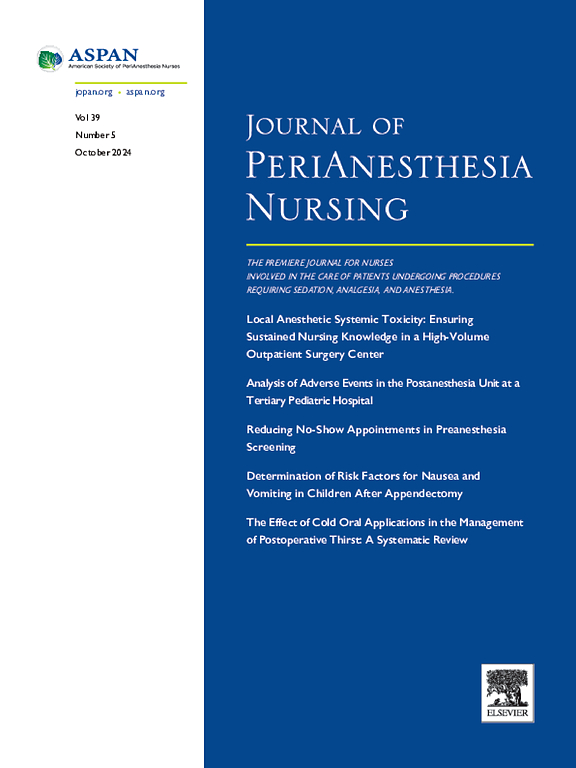在静脉区域麻醉中将氯胺酮加入利多卡因的有效性和安全性:随机对照试验的 Meta 分析。
IF 1.6
4区 医学
Q2 NURSING
引用次数: 0
摘要
目的:系统评估在利多卡因(L)中加入氯胺酮(K)进行静脉区域麻醉(IVRA)的有效性和安全性:设计:系统综述和荟萃分析:从开始到 2023 年 3 月,对 Cochrane 图书馆、Embase、PubMed、Web of Science 和 ProQuest 数据库以及 Google Scholar 搜索引擎进行了全面检索。所有检索到的文章都被导入 Endnote X20 软件,并由两名研究人员根据预先确定的纳入和排除标准进行独立筛选。数据使用Revman 5.4软件进行分析,评估结果包括感觉和运动阻滞发生时间、感觉和运动阻滞恢复时间、芬太尼用量、止血带疼痛发生时间、术中和术后视觉模拟量表评分以及并发症:荟萃分析共纳入了 11 项随机对照试验中的 532 名患者。结果表明,感官时间(P 结论:P 结论:P 结论:P 结论:P 结论:P 结论:P 结论:P 结论:P 结论:P 结论在 IVRA 中加入 K 和 L 可缩短起始时间、延长阻滞时间并减轻术中和术后疼痛,同时不会增加并发症。本文章由计算机程序翻译,如有差异,请以英文原文为准。
Efficacy and Safety of Adding Ketamine to Lidocaine in Intravenous Regional Anesthesia: A Meta-analysis of Randomized Controlled Trials
Purpose
To systematically evaluate the efficacy and safety of adding ketamine (K) to lidocaine (L) for intravenous regional anesthesia (IVRA).
Design
A systematic review and meta-analysis.
Methods
A comprehensive search of the Cochrane library, Embase, PubMed, Web of Science, and ProQuest databases, and the Google Scholar search engine was conducted from inception to March 2023. All retrieved articles were imported into Endnote X20 software and independently screened by two researchers according to predetermined inclusion and exclusion criteria. The data were analyzed using Revman 5.4 software and the assessed outcomes included the time of sensory and motor block onset, time of sensory and motor block recovery, fentanyl consumption, time of tourniquet pain onset, intraoperative and postoperative visual analog scale scores, and complications.
Findings
A total of 532 patients from 11 randomized controlled trials were included in the meta-analysis. The results showed that the time of sensory (P < .00001) and motor block onset (P < .00001) were shorter in the L + K group than in the L-only group. The time of sensory (P = .01) and motor block recovery (P = .006) and time of tourniquet pain onset (P < .00001) were longer in the L + K group than in the L-only group. There was a significant reduction in fentanyl consumption (P = .0002) in the L + K group compared to the L-only group. Moreover, the visual analog scale scores in the L + K group were significantly lower than the L-only group 10 minutes (P = .04), 20 minutes (P = .0004), 30 minutes (P < .00001), and 40 minutes (P < .0001) after tourniquet inflation, and 5 minutes (P < .00001), 15 minutes (P = .04), 30 minutes (P = .008), 1 hour (P = .002), 2 hours (P < .00001), and 4 hours (P < .00001) after tourniquet deflation. There was no evidence that the use of K as an adjuvant in IVRA increased adverse effects.
Conclusions
The addition of K to L in IVRA shortened the onset time, prolonged the block time, and reduced intraoperative and postoperative pain without increasing complications.
求助全文
通过发布文献求助,成功后即可免费获取论文全文。
去求助
来源期刊

Journal of Perianesthesia Nursing
NURSING-
CiteScore
2.20
自引率
17.60%
发文量
279
审稿时长
90 days
期刊介绍:
The Journal of PeriAnesthesia Nursing provides original, peer-reviewed research for a primary audience that includes nurses in perianesthesia settings, including ambulatory surgery, preadmission testing, postanesthesia care (Phases I and II), extended observation, and pain management. The Journal provides a forum for sharing professional knowledge and experience relating to management, ethics, legislation, research, and other aspects of perianesthesia nursing.
 求助内容:
求助内容: 应助结果提醒方式:
应助结果提醒方式:


